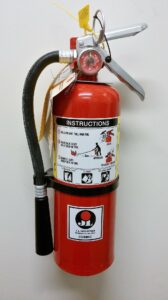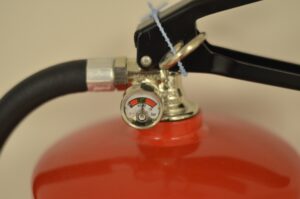If you own a business, you likely have fire extinguishers in your building. However, many people don’t realize how important these fire safety devices are! We’ve compiled a 101 guide on extinguishers to help you improve your fire safety.
Commercial Buildings Need Fire Extinguishers
You may have noticed that almost every commercial and public building has extinguishers, but you might not realize that in most places they’re required by law. Yes, even if you have other types of fire suppression systems in Houston, like clean agent systems, you still typically need portable extinguishers placed throughout your building. Why is this? Because they can be incredibly effective at saving lives and property by fighting small fires before they spread. While they won’t replace the need for suppression systems and alarms, they’re an important fire safety tool.

Where to Put Fire Extinguishers
Where you place extinguishers depends on many different factors, like the size and layout of your space and what fire hazards exist in your facility. However, in general you want to make sure that extinguishers are no more than 75 feet apart and that every employee is within 75 feet of an extinguisher. This is typically the minimum, but more strict rules may apply depending on your business and building, so check with one of our fire and life safety specialists for specifics.
Also, in most cases you want to mount extinguishers to the wall for easy access. Generally, you want to also make sure there are extinguishers near exits. That way a person who uses the extinguisher can evacuate if the fire spreads or becomes too big.
Types of Extinguishers
In addition, you’ll also need to figure out what kind of extinguisher is best for your facility. You need to fight different types of fires with different types of things. For instance, you probably know not to throw water on a grease fire, so if there’s a chance of a grease fire, you don’t want to only have water mist extinguishers on hand.
Here are the most common types of extinguishers available:
- ABC Dry Chemical: These can be used for Class A, B, and C fires, which include ordinary combustibles like wood, flammable liquids and gases, and electrical fires such as from copy machines. These work great for many office environments. One important drawback for these is that they contain corrosive chemicals that should be cleaned up ASAP.
- Class K Wet Chemical: Class K extinguishers use a wet chemical foam to help put out cooking fires. The foam covers the area to help prevent reignition from a grease fire due to cooking.
- Water Mist: These extinguishers use pressurized water to help stop fires, which may be better for facilities with sensitive equipment compared to the corrosive chemicals in ABC extinguishers. However, keep in mind that they should only be used for class A and C fires, and using these on a grease fire could have potentially fatal results.
- Carbon Dioxide: These use carbon dioxide gas to help suffocate fires without leaving behind any residue. However, keep in mind that they’re not meant for class B fires or fires caused by combustible metals. Also, carbon dioxide gas can pose a health hazard to humans, so they shouldn’t be used in small rooms or rooms with little ventilation.
- D-Type: These use sodium chloride powder to help with class D fires caused by combustible metals, which makes them great for lab environments.
Training Your Employees to Use Extinguishers
Now you know what type of extinguishers there are and where to place them, it’s also important to consider how to use them. In many cases, providing training to your employees on fire extinguishers and how to use them can be incredibly useful as part of your fire safety plan. In some cases, it may even be required by OSHA.
OSHA Requirements for Extinguisher Operation Training
Generally speaking, OSHA requires you to provide extinguisher training to your employees. This includes knowing not only how to safely operate an extinguisher, but also when to use it. For instance, you might train an employee on which types of extinguishers to use for different types of fires, what they should do before using an extinguisher, when it might be useful to use an extinguisher, and operating procedures for extinguishers. Typically you’ll need to provide this training at the time you hire a new employee and then once a year afterward.
There are exceptions to this rule, however. For instance, if your fire safety policy is to have everyone immediately evacuate your building once your fire alarm in Houston sounds, then you may not need to train your employees on extinguishers. Also, you can designate certain personnel to use the extinguishers while all others evacuate. In this instance, OSHA may allow you to provide training only to select employees.
How to Use Fire Extinguishers
When it comes to safe extinguisher operation, you can generally remember the acronym PASS:
- Pull the pin out and release the extinguisher lock
- Aim the nozzle at the base of the fire
- Squeeze the handle
- Sweep the nozzle from side to side at the base of the fire
However, it’s important to remember that extinguishers are really only meant for small fires that have just begun. This is called an incipient fire and usually you’ll need to catch it within the first few minutes once it begins. An incipient fire:
- Is localized
- Has relatively low heat
- The smoke doesn’t affect visibility in the room
- Smoke doesn’t hinder breathing
After this stage, it’s usually safer to evacuate than try to use an extinguisher. Also, if you use the extinguisher and the fire doesn’t completely go out or if it reignites, it’s also time to evacuate.
Before using an extinguisher, you should always alert the building of the fire so people can start evacuating and call 911. You should also make sure you have a clear escape route and evacuate before any fire, smoke, or heat gets in the way of that route.
Inspections and Maintenance for Fire Extinguishers
In addition, extinguishers need regular inspections and maintenance for proper fire safety and compliance. This includes monthly inspections, annual tests and maintenance, and other services. These can help ensure your extinguishers are ready to use when you need them.
Monthly Inspections
Extinguishers need monthly visual inspections for compliance. You can conduct these yourself or you can appoint an employee to do so. This involves looking at the extinguisher to make sure that it’s accessible and in the right place. You’ll also need to check the pressure gauge to make sure it’s in the green area for proper pressure and check for any visible damage. In many cases, you may also need to dust them off to keep them clean. Keep a record of these monthly inspections that notes the date and the person who conducted the inspection.

Annual Maintenance
In addition to monthly inspections, you’ll also need annual inspections and maintenance from a certified technician. These include an inspection, internal exam, and any required maintenance. For instance, you may need a hydrostatic test as part of your maintenance. How often you need this pressure test depends on the manufacturer’s instructions, but they’re generally every five to 12 years. You’ll also need to keep records of these services for proper fire safety compliance.
Fire Extinguisher Shelf Life
Also, many people don’t realize that fire extinguishers do have a shelf life. How long that life is depends on a lot of different things, like the type of extinguisher, the manufacturer, and whether it’s disposable or rechargeable. Rechargeable extinguishers can be refilled, while disposable extinguishers are a single-use solution that need to be replaced after each use. You must recharge rechargeable extinguishers at least every six years. For disposable extinguishers, you should replace them at least every 12 years.
Fire Suppression Systems in Houston from Wilson Fire Equipment
Need to protect your facility from fires and security issues? Our team at Wilson Fire Equipment is here to help! We have innovative solutions to help with fire detection, suppression, and other life safety and security issues. We’ve been a leader in life safety and security systems since 1916 and are confident we can meet your specific needs. Whether you need system design, installation, monitoring, or service, we guarantee your satisfaction. Call us now at (713) 896-4747 to discuss your fire safety needs with our specialists and get a free quote!
